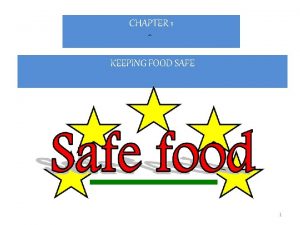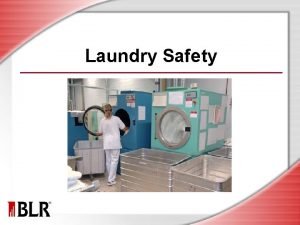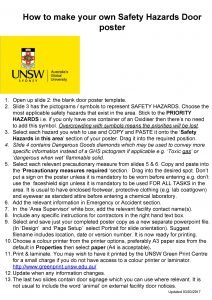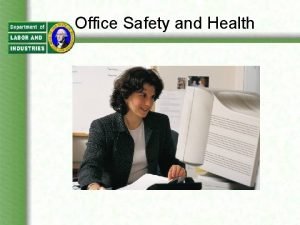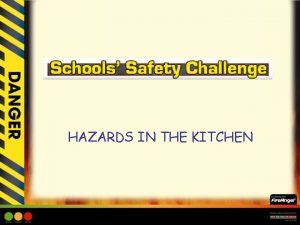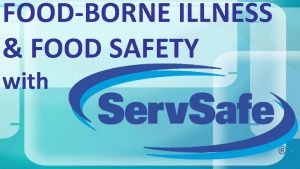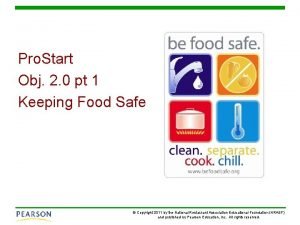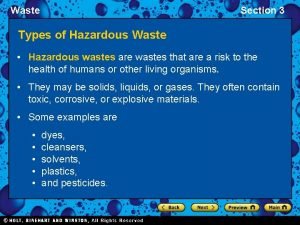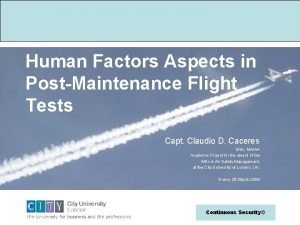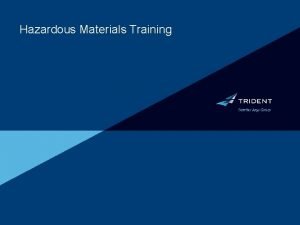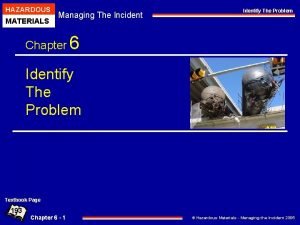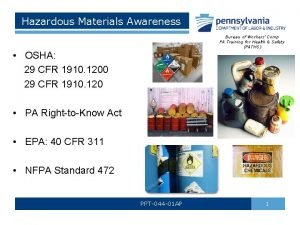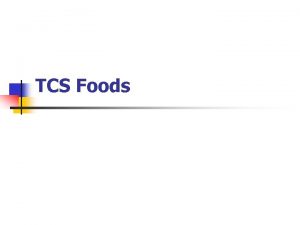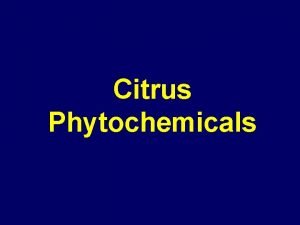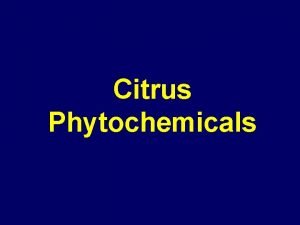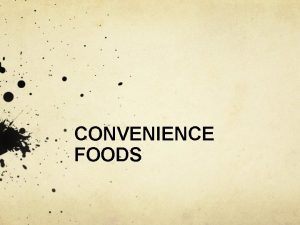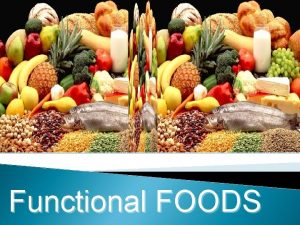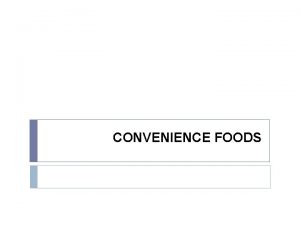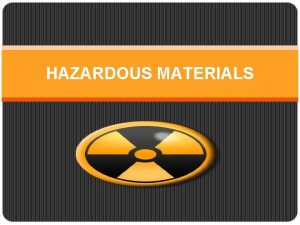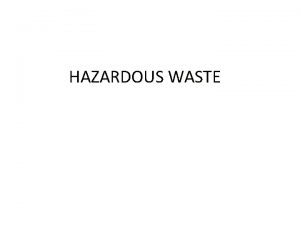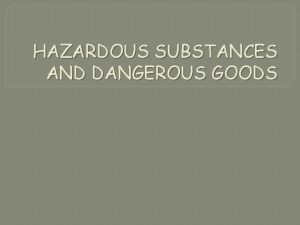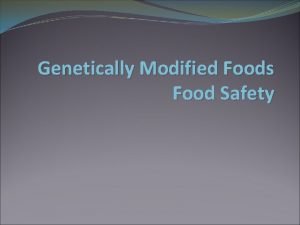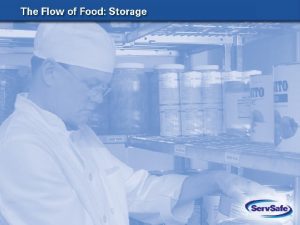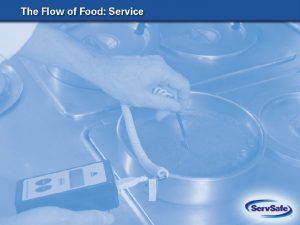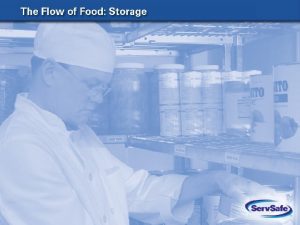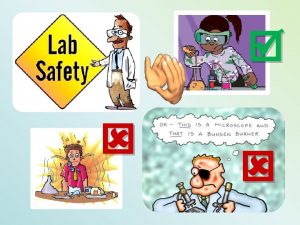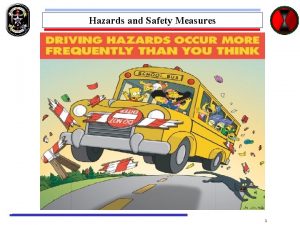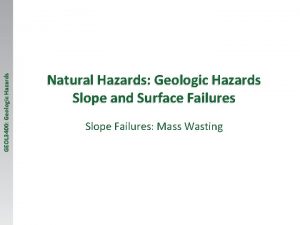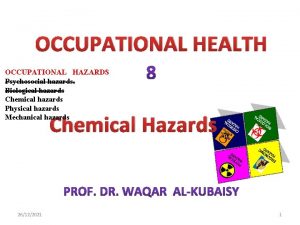Food Safety Food Hazards Potentially Hazardous Foods 1



















- Slides: 19

Food Safety Food Hazards

Potentially Hazardous Foods 1. Read and circle the foods that you believe are potentially hazardous. (2 minutes) 2. With a partner share your circled food items and explain your reasoning for circling. 3. Non-volunteers share your partner’s food items and reasoning.

Potentially Hazardous Foods o Foods that offer a friendly environment for the growth of pathogens (diseaseproducing organisms) o FAT TOM (the conditions that pathogens need to grow) § F- Food § T- Time § A- Acidity § O- Oxygen § T- Temperature § M- Moisture

Food Hazards o There are 3 primary food hazards n Chemical n Physical n Biological

Chemical Hazards n n n Cleaning compounds Bug sprays Food additives Fertilizer Toxic metals o Mercury o Cadmium o Lead

Chemical Hazard Preventions o Do not store chemicals over or next to food o Do not store chemicals in food containers o Do not store food in chemical containers o Label all containers with the common chemical name

Physical Hazards o Foreign objects, usually large enough to see or feel. n n Hair Food packaging Metal Glass

Preventing Physical Hazards o Maintain equipment o Thoroughly wash produce and remove foreign matter o Safely store food

Biological Hazards o Living organisms found in or on foods that can make us sick n Bacteria- single celled organisms found in food and water, on skin or clothing n Viruses- invades living cells and reproduces n Parasites- multi-celled organisms n Fungi- single-celled or multi-celled and creates toxins as it grows

What is a foodborne illness? o An illness that results from eating contaminated food o 48 million people contract a food borne disease per year resulting in 3, 000 deaths o Most food borne outbreaks go unreported

High Risk Groups o EVERYONE is potentially at risk for food-borne illness, but the following groups are at higher risk than others: n n Children Pregnant women Seniors Individuals with compromised immune systems

Some Bacteria Diseases Bacteria/Disease Common Sources Campylobacteriosis Contaminated water; unpasteurized milk; undercooked meat, poultry and seafood Botulism Improperly processed, home-canned and commercially canned foods; vacuum packed or tightly wrapped foods E. coli Unchlorinated water, raw or rare ground beef; unwashed produce; unpasteurized milk Salmonella Raw or undercooked poultry, eggs, meat and seafood; unpasteurized milk Staphylococcus aureus Prepared foods left too long at room temperature. Meat, poultry, egg products and such mixtures as tuna, chicken, potato and egg salad; cream filled pastries

Direct Contamination o When food is received by the restaurant that is already contaminated.

Cross Contamination o Occurs when food that is safe comes in contact with contaminants while it is being prepared, cooked, or served. § § § Separate cooked and ready-to-eat foods from raw foods. Do not taste and cook with the same spoon. Never use the same utensil, cutting board, or plate for raw and cooked foods.

Personal Hygiene o Wash hands in warm, soapy water for 20 seconds o Keep hair tied back o Wear clean apron or uniform o Remove jewelry o Stay home when sick § § § § When arriving at work and before returning to the kitchen After using the bathroom After sneezing or coughing After eating or drinking After handling garbage After touching raw meat Anytime you change from one task to another

Sanitizing o Using either heat or chemicals to reduce the number of pathogens o Hand Washing (manual sanitizing) n n Wash Rinse Sanitize Air Dry

Temperature Danger Zone o The temperature range at which pathogens grow. o 41 degrees to 135 degrees

Cooking raw meat, poultry, seafood, and eggs to a safe internal temperature can kill harmful bacteria. • Use a thermometer to check food temperatures. • Do not taste uncooked or partially cooked dishes. • Reheat foods thoroughly to 165 degrees F.

Chill o Do not allow foods to sit out longer than 2 hours. n Divide larger amounts of food into small portions to chill faster. o Refrigerators should be kept at 40 degrees Fahrenheit or below. o Freezers should be kept at 0 degrees or below o Thaw foods in refrigerator o When in doubt “Throw it Out!”
 Potentially hazardous food is usually moist
Potentially hazardous food is usually moist Potentially shippable product increment
Potentially shippable product increment Potentially renewable examples
Potentially renewable examples Laundry hazards
Laundry hazards Door hazards
Door hazards Office hazards
Office hazards Safety kitchen hazards picture
Safety kitchen hazards picture What are three types of hazards that make food unsafe?
What are three types of hazards that make food unsafe? Potential food hazards
Potential food hazards Surf safe test
Surf safe test Example of physical hazard
Example of physical hazard What is food safety
What is food safety Section 3 hazardous waste answers
Section 3 hazardous waste answers Aviation hazardous attitudes
Aviation hazardous attitudes Biomedical waste definition
Biomedical waste definition Hazardous materials table
Hazardous materials table Hazardous materials table
Hazardous materials table Hazardous
Hazardous Hazwoper
Hazwoper Avhf
Avhf
